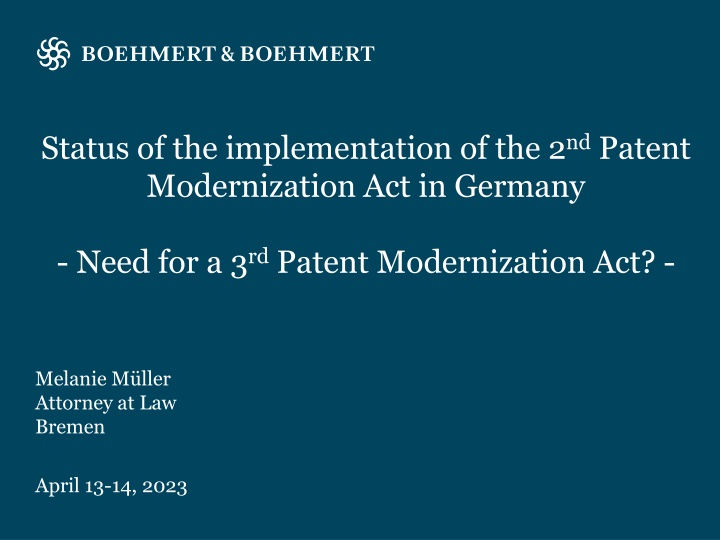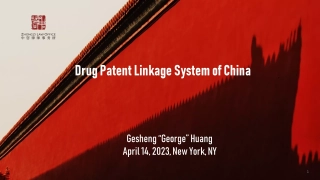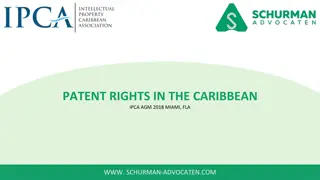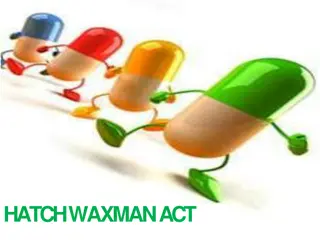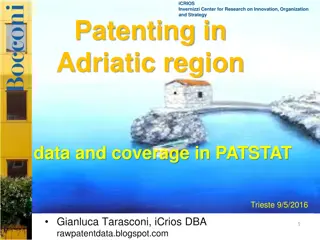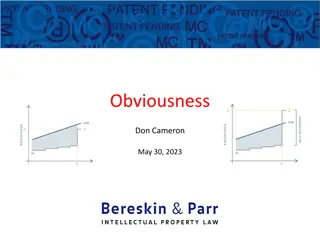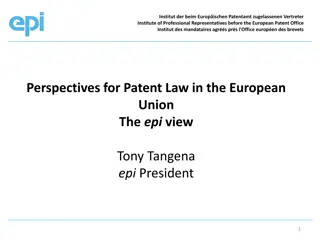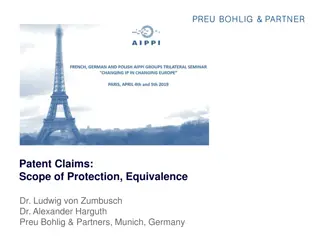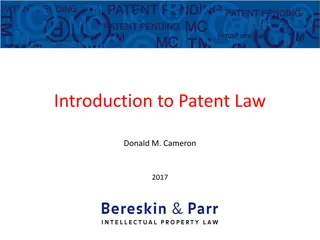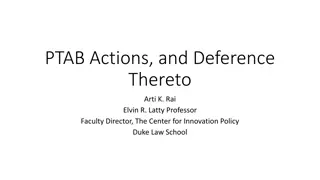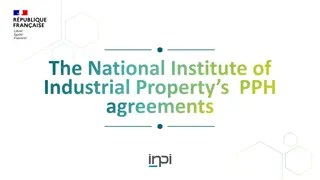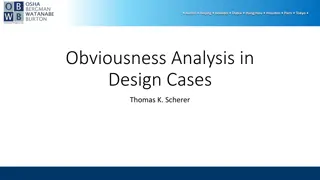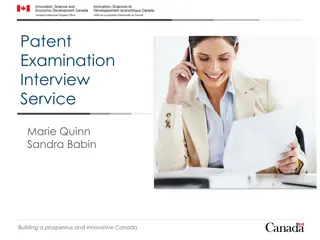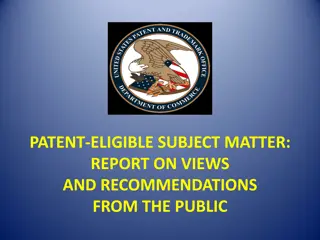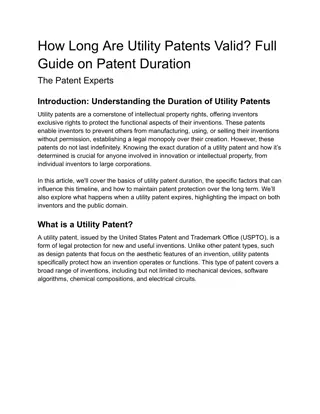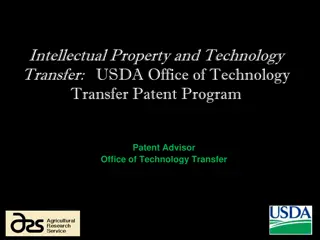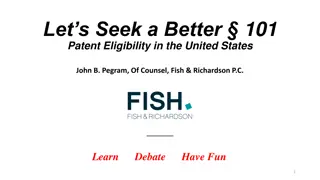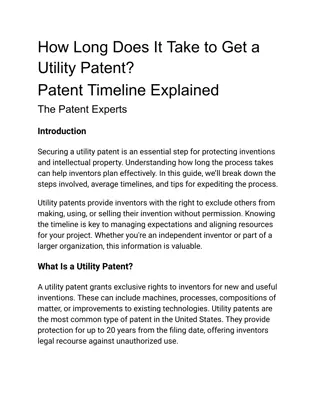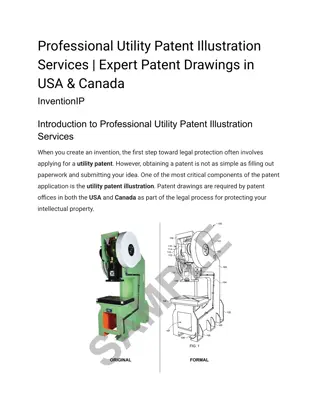Status of 2nd Patent Modernization Act in Germany
The implementation of the 2nd Patent Modernization Act in Germany and the need for a potential 3rd Patent Modernization Act are discussed in relation to the current legal landscape. Key topics include the injunctive relief under the German Patent Act, the Injunction Gap, and implications for litigation proceedings. Analysis of court practices, challenges with quasi-automatism, proportionality issues, and perspectives on the amendment to Sec. 139 para. 1 GPA are explored. Uncertainties persist regarding third-party interests, proportionality assessments, and compensation claims.
Download Presentation

Please find below an Image/Link to download the presentation.
The content on the website is provided AS IS for your information and personal use only. It may not be sold, licensed, or shared on other websites without obtaining consent from the author.If you encounter any issues during the download, it is possible that the publisher has removed the file from their server.
You are allowed to download the files provided on this website for personal or commercial use, subject to the condition that they are used lawfully. All files are the property of their respective owners.
The content on the website is provided AS IS for your information and personal use only. It may not be sold, licensed, or shared on other websites without obtaining consent from the author.
E N D
Presentation Transcript
Status of the implementation of the 2ndPatent Modernization Act in Germany - Need for a 3rdPatent Modernization Act? - Melanie M ller Attorney at Law Bremen April 13-14, 2023 1
Outline Topic 1: The injunctive relief Sec. 139 para. 1 German Patent Act (GPA) Topic 2: The Injunction Gap 2
Topic 1: The injunctive relief Sec. 139 para. 1 GPA Sec. 139 para 1 GPA old version Sec. 139 para. GPA new version "Whoever uses a patented invention in contravention of Sections 9 to 13 may be sued by the infringed party for an injunction if there is a risk of repetition. The claim also exists if an infringement is threatened for the first time." Whoever contravention of Sections 9 to 13 may be sued by the infringed party for an injunction if there is a risk of repetition. The claim shall also exist if an infringement is threatened for the first time. The claim is excluded if the claim would lead to disproportionate hardship for the infringer or third parties not justified by the exclusive right due to the special circumstances of the individual case and the requirements of good faith. In this case, the infringed party shall compensation in money. The claim for damages under paragraph 2 shall remain unaffected. uses a patented invention in be granted appropriate 3
Background: Germany as leading litigation forum for (patent) infringement proceedings. - Possible reasons: - Strong market position. - Fast and efficient procedures. - Bifurcated System. -Granting of quasi automatic injunctive reliefs. - Objections e.g. Sec. 275 or Sec. 242 BGB (German Civil Law Code) de facto did not prevail. - Also not the influence of the binding EU Law (Art. 3 Enforcement Directive or unwritten principle of proportionality). 4
- "Quasi-automatism not justice to the - increasing complexity of inventions, - outcome of trolls and - injunction gap . - Court practice has been critizised more and more. - W rmetauscher decision of the Federal Supreme Court in Germany in 2016 discussed proportionality and objections like Sec. 275 BGB. - But German court practice did not changed. - Literature has tried to find the solution on the side of the enforcement of judgements. - Regarding injunction gap: Amount of the security payment. - German Legislator choose another solution with the 2. PatMoG. 5
Comments on the (new) Sec. 139 para. 1 GPA Pro Contra Lack of clarity regarding third-party interests (including general/public interests?). + Amendment to Sec. 139 para. 1 GPA expressly clarifies that patent law injunctive relief may be restricted in individual cases by way of exception. + Practice shows that courts are looking more intensively at proportionality issues. + In practice, it remains with the granting of strong injunctive relief. Sec. 9 German Trade Secrets Act shows that legislators differentiates between third-party interests and public interest. Uncertainty regarding the relationship between Sec. 139 para. 1 s. 3 GPA and Sec. 24 GPA. Lack of clarity regarding calculation of compensation claim under Sec. 139 para. 1 s. 4 GPA. 6
Conclusion to Topic 1: Amendment of Sec. 139 para. 1 s. 3 GPA: The claim is excluded insofar as the claim would lead to disproportionate hardship for the infringer, third parties or the general public not justified by the exclusive right due to the special circumstances of the individual case and the requirements of good faith. Clarification with regard to third party interests (if applicable, general interests): Differentiated decision. Relationship to compulsory license: Different legal institutions with different legal effects (thus no subsidiarity). Creation of legal clarity and legal certainty with regard to the compensation claim(Sec. 139 para. 1 s. 4 GPA): Clarification of the dogmatic classification and/or the meaning and purpose. Specification of concrete assessment methods? 7 7
Topic 2: Injunction Gap The goal of the 2nd Patent Modernization Act (PMA): Better synchronization of infringement proceedings (before German Regional Courts) and nullity proceedings (before German Federal Patent Court). Pursued solution: Acceleration of the proceedings before the Federal Patent Courts by adapting Sec. 81 et seq. GPA. This means that enforcement law solutions have been rejected. 8
Concrete Changes of 2nd PMA: Sec. 83 para. 1 GPA Sec. 81 para. 5 GPA "In the proceedings for a declaration of nullity of the patent or supplementary protection certificate, the patent court shall, as early as possible, draw the attention of the parties to aspects which are likely to be of particular importance for the decision or are conducive to concentrating the hearing on the issues essential for the decision. This notice shall be given within six months after service of the legal action. If a patent case is pending, the notice shall also be sent to the other court ex officio. The patent court may set a time limit for the parties to submit a final written statement in preparation for the reference under the first sentence. If the patent court does not set a time limit, the reference may not be made before the expiry of the time limit under Sec. 82 para. 3 s. 2, 3. Comments of the parties received after the expiry of the time limit need not be taken into account by the patent court for the reference. A reference under the first sentence shall not be necessary if the aspects to be discussed appear obvious from the arguments of the parties. Sec. 139 of the Code of Civil Procedure shall apply in addition." "The legal action must specify the plaintiff, the defendant and the subject matter of the dispute, and shall contain a specific request. The facts and evidence supporting the legal action shall be stated. If the application does not fully comply with these requirements, the presiding judge shall invite the applicant to make the necessary additions within a specified period of time. The court file number of a patent dispute concerning the patent in suit and its amount in dispute shall be indicated." Sec. 82 para. 1, 3, 4 GPA "(1) The patent court shall immediately serve the legal action on the defendant and invite him to make a statement thereon within one month. (3) If the defendant opposes in due time, the Patent Court shall notify the plaintiff of the opposition. The defendant may state the reasons for the opposition within two months after service of the legal action. The presiding judge may, upon request, extend the time limit by up to one month if the defendant shows substantial grounds for doing so. These shall be substantiated. Section 81 para. 5 s. 3 shall apply mutatis mutandis insofar as the relevant information is not already apparent from the statement of legal action." 9
Comments on Sec. 81 GPA Need for an amendment de lege ferenda? New version de lege lata Original proposed amendment of Sec. 81 para. 2 s. 2 GPA-Draft: ("This shall not apply insofar as an infringement suit has been filed; the opposition shall become inadmissible insofar as an action for nullity is filed."). New provision of Sec. 81 para. 5 s. 3 GPA provides that court file number and amount in dispute of a known patent litigation shall already be communicated with the legal action. This should allow nullity actions to be brought before Federal Patent Court already when opposition to patent can still be filed or opposition proceedings are pending. This applies to patent infringement proceedings in which the plaintiff himself is involved or in which third parties are involved (affiliated companies). Proposed amendment should only apply if legal action for infringement of the patent in question has been brought before Regional Court. Equality of arms. Avoidance of conflicting decisions. Process acceleration. 10
Comments on Sec. 82 GPA Need for an amendment de lege ferenda? New version de lege lata Sec. 82 para. 1 GPA clarifies that the obligation to serve the legal action undue delay (Sec. 271 para. 1 Civil Procedure Act), which applies in civil proceedings, also applies in invalidity proceedings before the Ferderal Patent Court. Sec. 82 para. 3 s. 5 GPA contains an editorial oversight, since reference is made to Sec. 81 para. 5 s. 3 GPA and not to Sec. 81 para. 5 s. 4 GPA. Sec. 82 para. 3 GPA serves to accelerate the proceedings, since a time limit provision is created for nullity eliminates the need for the court to set a time limit. proceedings, which Streamlining process. and accelerating the Only an editorial oversight would need to be corrected here. 11
Comments on Sec. 83 GPA Need for an amendment de lege ferenda? New version de lege lata Qualified infringement proceedings before Regional Courts. notice is made fruitful for Adaptation of the wording of Sec. 83 para. 1 s. 2 GPA by changing the word "shall" to "must". Shall provision expresses that it is a "recommendation" of the legislator. Transmission to infringement court takes place ex officio within six months after service of the nullity action. In order that the period of six months starts promptly, Sec. 82 para. 1 GPA provides for immediate service of the legal action. Streamlining of the procedure. Federal Patent Courts reference should be available before the first-instance decision of the Regional Court. Replace "shall" provision with (possibly softened) "must" provision. 12
Conclusion to Topic 2: Adaptation of Sec. 81 GPA and addition/insertion of a Sec. 81 para. 2 s. 2 GPA with the following wording: "This shall not apply insofar as an infringement action has been filed; the opposition shall become inadmissible insofar as a nullity action is filed." Correction of editorial oversight in Sec. 82 para. 3 s. 5 GPA. Adaptation of Sec. 83 para. 1 s. 2 GPA with the following wording: "This notice must be given within six months after service of the action. If necessary: Additional softening/exception if it is impossible for the court to issue the notice within the stated period. 13 13
Thank you for your attention. Melanie M ller BOEHMERT & BOEHMERT Hollerallee 32 28209 Bremen E-Mail: melanie@boehmert.de mueller- 14 14
